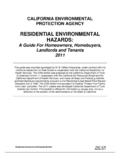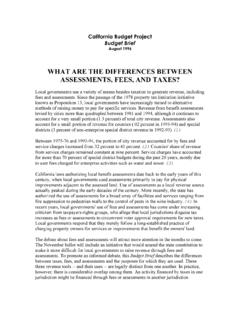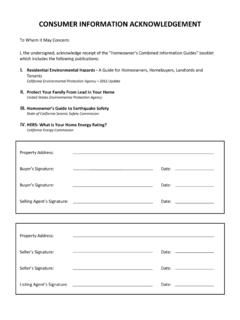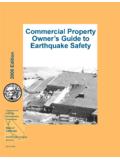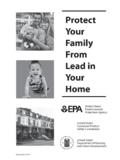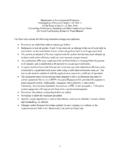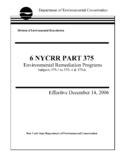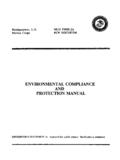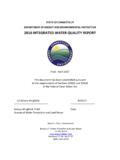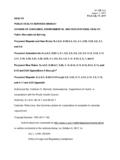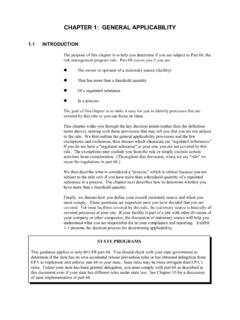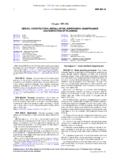Transcription of RESIDENTIAL ENVIRONMENTAL HAZARDS - …
1 RESIDENTIAL ENVIRONMENTAL HAZARDS Booklet Page 1 of 48 January 2011 CALIFORNIA ENVIRONMENTAL PROTECTION AGENCY RESIDENTIAL ENVIRONMENTAL HAZARDS : A Guide For Homeowners, Homebuyers, Landlords and Tenants 2011 This guide was originally developed by M. B. Gilbert Associates, under contract with the California Department of Real Estate in cooperation with the California Department of Health Services. The 2005 edition was prepared by the California Department of Toxic Substances Control, in cooperation with the California Air Resources Board and the California Department of Health Services, and meets all State and Federal guidelines and lead disclosure requirements pursuant to the RESIDENTIAL Lead-Based Paint Hazard Reduction Act of 1992.
2 The 2005 edition incorporates the Federal Protect Your Family from Lead pamphlet. The 2011 update was developed California Department of Toxic Substances Control. This booklet is offered for information purposes only, not as a reflection of the position of the administration of the State of California. RESIDENTIAL ENVIRONMENTAL HAZARDS Booklet Page 2 of 48 January 2011 Table of Contents INTRODUCTION 3 CHAPTER I ASBESTOS 3 CHAPTER II CARBON MONOXIDE 10 CHAPTER III FORMALDEHYDE 13 CHAPTER IV HAZARDOUS WASTE 17 CHAPTER V HOUSEHOLD HAZARDOUS WASTE 21 CHAPTER VI LEAD 24 CHAPTER VII MOLD 31 CHAPTER VIII RADON 36 APPENDIX A LIST OF FEDERAL AND
3 STATE AGENCIES 42 APPENDIX B GLOSSARY 46 RESIDENTIAL ENVIRONMENTAL HAZARDS Booklet Page 3 of 48 January 2011 Introduction The California Departments of Real Estate and Health Services originally prepared this booklet in response to the California legislative mandate (Chapter 969, Statutes of 1989, AB 983, Bane) to inform the homeowner and prospective homeowner about ENVIRONMENTAL HAZARDS located on and affecting RESIDENTIAL property. The 2005 edition was prepared by the California Department of Toxic Substances Control, in cooperation with the California Air Resources Board and the California Department of Health Services Childhood Lead Poisoning Prevention Program, Radon Program, and Division of Drinking Water and ENVIRONMENTAL Management, in response to a 1994 legislative mandate (Chapter 264, Statutes of 1994, AB 2753, Sher).
4 The 1994 legislation also requires this booklet to consolidate the California disclosure requirements (Ch. 969, Statutes of 1989) and the federal disclosure requirements (The RESIDENTIAL Lead-Based Paint Hazard Reduction Act of 1992). The information contained in this booklet is an overview of some ENVIRONMENTAL HAZARDS which may be found on or in RESIDENTIAL property and which may affect RESIDENTIAL real estate. Since this booklet is not meant to be all inclusive, it should be used only for general guidance. Although law requires the disclosure of known HAZARDS , an ENVIRONMENTAL survey may be conducted to obtain further information.
5 Homeowners, tenants, and prospective homeowners may wish to obtain other literature for additional information on HAZARDS of concern. In California, sellers are required to disclose the presence of any known ENVIRONMENTAL hazard. A statement that the homeowner is unaware of ENVIRONMENTAL HAZARDS is not a guarantee that the property is free of such HAZARDS . It is in the homeowner s and prospective homeowner s interest to know what HAZARDS are common, where they are found, and how they might be mitigated. This booklet will provide homeowners and prospective homeowners with the information and additional resources needed to make an informed decision about ENVIRONMENTAL HAZARDS that may be present on a property.
6 Because of the contribution of household hazardous wastes to the problem of hazardous waste disposal, a section on proper storage and disposal of household hazardous products is included. In discussing health impacts of hazardous substances, lifetime exposure to low levels is emphasized because the resident is more likely to encounter this type of exposure than exposure to high levels of HAZARDS for a short time. Sources of additional information and a list of government agencies are provided for further information. Pursuant to AB 983, if this ENVIRONMENTAL HAZARDS booklet is made available to homeowners or prospective homeowners, real estate licensees and home sellers are not required to provide additional information on such HAZARDS .
7 However, delivery of this publication to homeowners or prospective homeowners does not relieve home sellers RESIDENTIAL ENVIRONMENTAL HAZARDS Booklet Page 4 of 48 January 2011 and real estate licensees of the responsibility to disclose the existence of ENVIRONMENTAL HAZARDS when such HAZARDS are known to them. The material is presented with the understanding that the publisher is not engaged in offering legal or other professional advice. If legal or other expert assistance is required, the services of a skilled professional should be obtained.
8 RESIDENTIAL ENVIRONMENTAL HAZARDS Booklet Page 5 of 48 January 2011 CHAPTER I ASBESTOS What is Asbestos? Asbestos is the name given to a number of naturally occurring fibrous silicate minerals that have been mined for their useful properties such as thermal insulation, chemical and thermal stability, and high tensile strength. The three common types of asbestos are chrysotile, amosite, and crocidolite. Chrysotile, also known as white asbestos and a member of the serpentine mineral group, is the most common.
9 Asbestos can only be identified under a microscope. Where is asbestos found in the home? Asbestos has been used in many products found in the home that provide insulation, strength, and fire protection. In 1989, the ENVIRONMENTAL Protection Agency ( EPA) announced a phased ban of asbestos products to be completed by 1996. However, in 1991, the Fifth Circuit Court of Appeals overturned and remanded the asbestos ban and phase-out rule to EPA. Today, most asbestos products can still be legally manufactured, although production of asbestos containing materials has decreased dramatically since the late 1970s.
10 The most common items in the home that may contain asbestos are: Vinyl flooring Duct wrapping on heating and air conditioning systems Insulation on hot water pipes and boilers Some roofing shingles, and siding Vermiculite attic insulation Ceiling and wall insulation Sheet rock taping compounds and some ceiling materials Asbestos that has been sprayed on ceilings often has a spongy, cottage cheese appearance with irregular soft surfaces. Asbestos troweled on walls has a textured, firm appearance.
